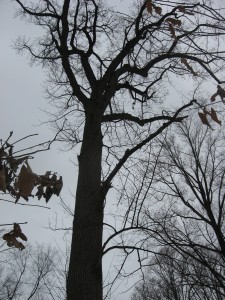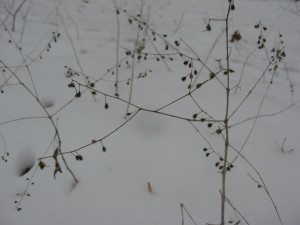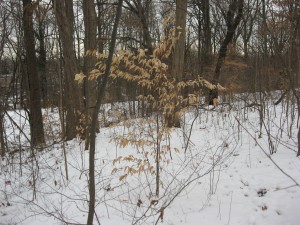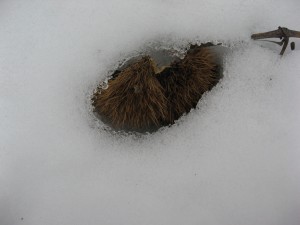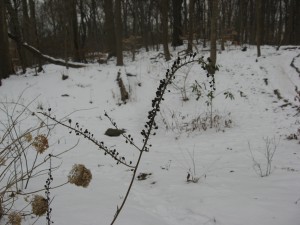
Our native plant garden has lots of personality even in the dead of winter, the middle of January. Our Black Cohosh (Actaea racemosa) maintains its posture. Like many herbaceous plants and trees in winter, Black Cohosh’s remaining stature provides an interesting and enduring silhouette , contributing to the winter architecture of our garden.
Enchanter’s Nightshade, (Circaea canadensis) has formed an elegant patch in the park right next to our yard. This wild woodland native is starting to grow along the edges of our cultivated and manicured native woodland garden. Hopefully a few will seed themselves in our yard, which directly borders Morris Park.
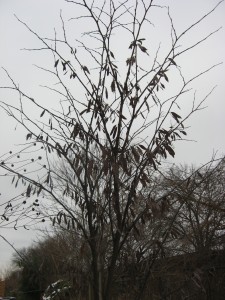
Eastern Redbud (Cercis canadensis) in our back-alley. Â Our newly planted edition to our back-alley garden has developed a classic redbud growth form, most visible in the winter. The often multi-stemmed small tree develops a vase-shaped form. In the winter, its many seedpods hang on to the branches, giving us the impression that the tree is still busy with its lifecycle, not fully embracing its dormancy.
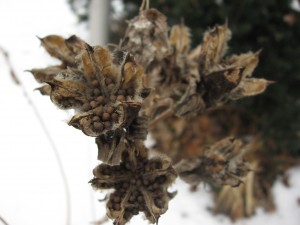
Our Hibiscus moscheutos, planted in the backyard next to the drainpipe outlet, obtained enough moisture and sun in 2010 to flower continuously for two months. Our Swamp Mallow left this stunning display of seeds for our January viewing.  The plant has very large, colorful and showy flowers. We found Swamp Mallow growing in the wild in the John Heinz National Wildlife Refuge in Tinicum Pennsylvania.  About 5 miles away from Morris Park, This National Treasure is part  our watershed.  Indian Creek, which flows right through Morris Park, drains into the John Heinz National Wildlife Refuge.
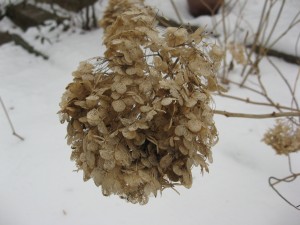
Hydrangea has an entertaining command of our winter garden landscape. The big fluffy balls have a whimsical appearance. Â This ‘Annabelle’ cultivar was unfortunately dumped into the park where it was found and rescued finding a home our yard.
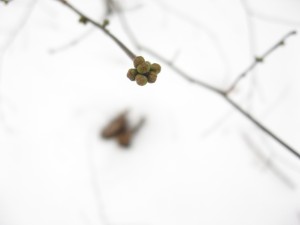
No longer in the yard, we venture into Morris Park, where we witness the beauty of the Spicebush (Lindera benzoin). This understory shrub is common on our site in Morris Park.
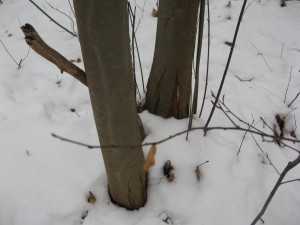
Members of the family Fagacaea hold a dominant place in the section of Morris Park we are focused on. Â This would include Beech, Chestnut and Oak. In the Winter, they all share a common trait that bonds them together as a family. Â The young trees hold on to their leaves into the winter season and the younger portions of older trees, hold on to their leaves as well.
An old beech tree will still have its leaves only in the center and lower portions of the tree in the middle of January, this being the area of the tree that was alive in its juvenile state.
Oaks will display this habit, but not as obviously as the beeches.  The many Chestnuts in our area also hold onto their leaves, but even less so than the oaks. The first photograph of the three above is of the lower trunk of  a Chestnut tree that is suffering from the Chestnut blight.  This is caused by the exotic fungus Cryphonectria parasitica that attacks the bark of the tree, splitting it apart, eventually killing the growth above.  This tree may not survive beyond the winter, however its roots are not effected by the fungus, and will grow new shoots. One can see how the fungus tears apart the bark of this fairly young growth in these elongated sections. Once the bark is completely severed by Cryphonectria, the upper portion of the tree dies.  However, the actual living plant is most likely hundreds of years old, and at one time may have been 100 feet tall, the dominant tree in the forest.
Growing right next to the dying Chestnut tree in the next picture is a young Beech, still holding onto its leaves. Â The Beeches are also vulnerable to a disease originating in Nova Scotia during the twenties called Beech bark disease, however we have not detected its presence in the forest.
The last picture is of the spiny Chestnut seed husk, still visible in the snow.
This was a significant event, that the tree even made seeds at all in its blighted state. We immediately notified the authorities of Philadelphia’s Fairmount Park System which oversees the entire park system.  They have a new seed propagation division which seeks to grow seeds of plants that have a local provenance in our area.  The intent is to maintain the integrity of the localized gene pool of the flora of the Philadelphia region. This fairly new concept of  genetic provenance is crucial to successful environmental restoration in our park.  The Park authorities responded immediately to responsibly collect seeds for propagation. We also collected a few seeds ourselves to try to propagate our local Castanea dentata for the future of the species.
The American Chestnut is self-sterile, which means that there needs to be at least two trees to  cross-pollinate, in order for their to be fertile, viable seeds. We searched the entire area to find another Chestnut tree that may have flowered and gone to seed, and found none.  So we are doubtful of the seeds we collected being fertile and viable.  But there are quite a few Chestnut trees in our area and there is always the possibility of there being another one somewhere that we missed, that had flowered. All we would need is the pollen from this flowering event to make it to the tree in our area, and we would have viable seed.
So, assuming the best scenario, we have a few seeds in our refrigerator, in ziplock bags containing a bit of moisture to keep them alive. We are replicating the need for the seeds requirement of Cold Stratification, that a certain amount of time is needed of cold temperatures for the seed to be able to germinate and grow into a new tree.
For us, to be able to perpetuate the American Chestnut that has been growing in Philadelphia would be a success. The trees in this area may very well provide the best chance of success for the reproduction of the  local provenance of Castanea dentata. We have been told that the largest concentration of Chestnut trees in Philadelphia are found in this one section of Morris Park. In our explorations of the Fairmount Park System, we have also come to this conclusion.
In the Spring, we will plant the few seeds we have collected, and see what happens. Â
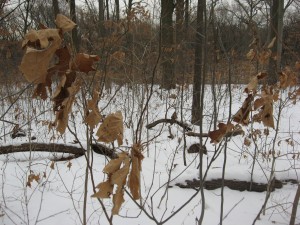
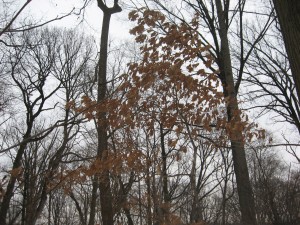
Growing among the notably straight trunks of Tulip Poplar, there is an abundance of oak saplings. Like the Beech, this Fagacae family member still has its leaves.
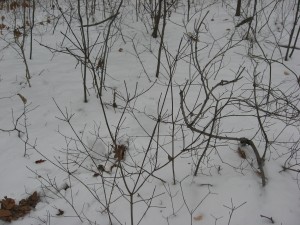
Saplings of dogwood against the backdrop of snow. Â Winter is an excellent time to become familiar with a tree’s silhouette. Learning the trees this way becomes easier as their distinct patterns emerge, and they are repeated, making them increasingly recognizable.
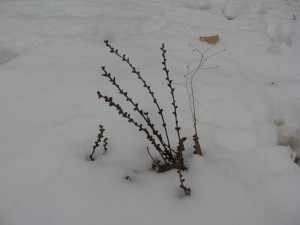
This plant is a parasite. It grows from the roots of Beech trees. We never noticed them for the longest time, until we read about them. Â So we started to look for them under the Beech trees, and there they were, 100’s of them! Now every time we see a Beech tree, we look for the Beech Drops (Epifagus virginiana). Â They can easily blend in with the leaf layer of the forest floor, with brown and purple stems, with yellowish-brown tips. Â A stunning display of Beech Drops in Fairmount Park occurs in Ormisten Glen, in East Park, where there is a magnificent stand of mature Beech trees. Â The path that leads south along the Schuylkill River out of Ormisten Glen continues the display of great Beech Drops.
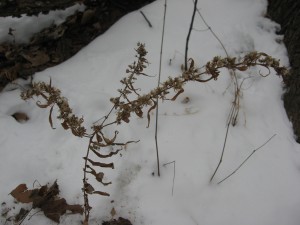
We watched this specific specimen grow all spring and summer.  We didn’t get too attached, knowing that at any time, a deer could come along and eat it. A lot of goldenrod in Morris Park was lost this way.  This one made it to flower, along with only a selection of others. Little by little, the seeds are blowing off  and hopefully this species will continue to grace Morris Park in the future.  Solidago canadensis
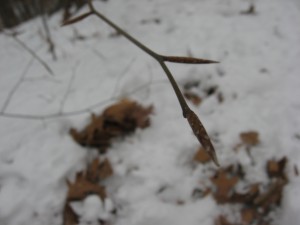
The winter buds of American Beech have alot of character. A very distinguishable characteristic is the zig-zag twig, with a tight, sharply defined terminal bud placed right at the intersection between the zig and the zag.
